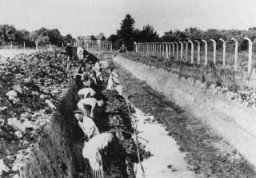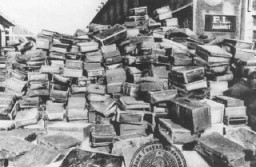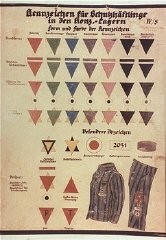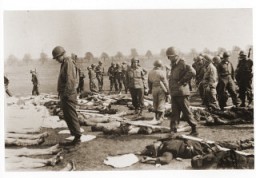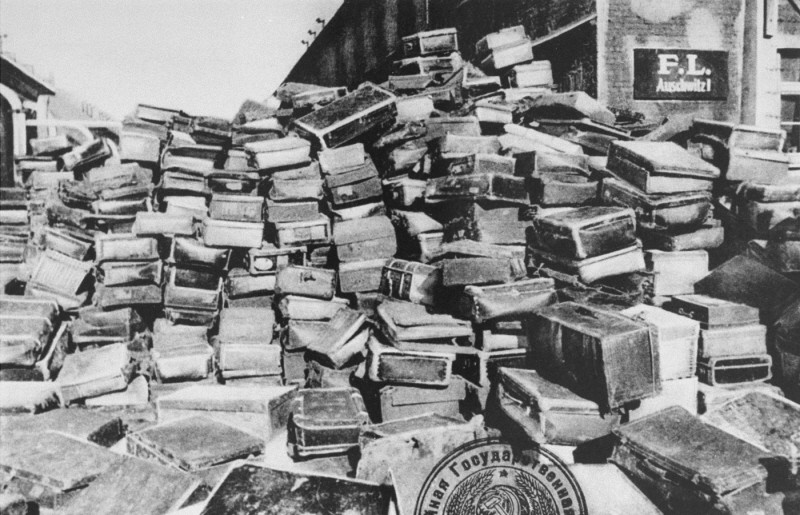
Concentration Camps, 1942–45
December 1941 saw both defeat of the German army in its attempt to take Moscow and the entry of the United States into World War II. It became clear to German authorities that Germany would have to fight a long war.
Facing growing labor shortages and the ongoing need to produce armaments, machinery, airplanes, and ships to replace German losses, the SS established more SS-owned firms. It also signed contracts with state and private firms to produce goods and provide labor for the German armaments and related industries. A famous example of cooperation between the SS and private industry was the I.G. Farben company's establishment of a synthetic rubber plant in 1942 at Auschwitz III (Monowitz).
Serving the German War Effort
The incarceration of increasing numbers of people in the concentration camps assured the quantity of the labor supply even as the brutality of life inside the camps depleted the number of available laborers. The SS used gas chambers and other means to "weed out" prisoners who were no longer able to work.
During 1942–1944, hundreds of subcamps were established for each concentration camp. Subcamps were located in or near factories or sites for the extraction of raw materials. For example,
- Wiener Neudorf, a subcamp of Mauthausen established in 1943, was located near an airplane factory on the east side of Vienna, Austria
- Sosnowitz was established in the vicinity of a coal mine as a subcamp of Auschwitz III/Monowitz
- prisoners incarcerated at Dora-Mittelbau worked under brutal conditions in underground factories for the production of rockets
Central SS authorities tried to persuade camp commandants to focus their efforts on keeping the prisoners alive to serve the German war effort. However, few of the commandants took these instructions seriously. None were concerned about changing the murderous culture of the camps.
Evacuations and Medical Experiments
During the last year of the war, as the Germans retreated into the Reich itself, the concentration camp population (Jewish and non-Jewish) suffered catastrophic losses due to starvation, exposure, disease, and mistreatment. In addition, the SS forcibly evacuated concentration camp prisoners as the front approached because the Nazis did not want the prisoners to be liberated. Under SS guard, prisoners had to march on foot during brutal winter weather without adequate food, shelter, or clothing. SS guards had orders to shoot those who could not keep up. Other prisoners were evacuated by open freight car in the dead of winter.
During this period, the concentration camps were also sites of hideous and perverted medical experiments conducted on prisoners against their will and often with lethal results. For example, in Dachau, German scientists experimented on prisoners to determine the length of time German air force personnel might survive under reduced air pressure or in frozen water. In Sachsenhausen, various experiments were conducted on prisoners to find vaccines for lethal contagious diseases. At Auschwitz III, the SS doctor Josef Mengele conducted experiments on twins to seek ways of increasing the German population by breeding families that would produce twins.
These experiments were criminal and murderous. They were also based for the most part on bogus science and racist fantasy.
Liberation
In 1944–1945, the Allied armies liberated the concentration camps. Tragically, deaths in the camps continued for several weeks after liberation. Some prisoners had already become too weak to survive.
According to SS reports, there were more than 700,000 prisoners left in the camps in January 1945. It has been estimated that nearly half of the total number of concentration camp deaths between 1933 and 1945 occurred during the last year of the war.
Critical Thinking Questions
- Where were the camps located? To what degree was the German population aware of the camps, their purpose, and the conditions within? How would you begin to research this question?
- Did the outside world have any knowledge about these camps? If so, what actions were taken by other countries and their officials? What choices did other countries have in the face of mistreatment of civilians?
- How and why did the function of the concentration camp system change in the middle of World War II?
- How do these camps differ from relocation or transit camps in other national histories? How are they similar to camps in other national histories?
- Explain the systematic nature of the attempt to annihilate the Jews of Europe. What kind of a society or government may be necessary for a systematic effort such as this?


